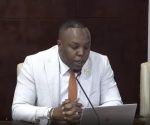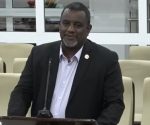The ENNIA-debacle: How Ansary ignored all red flags
 PHILIPSBURG – It took until July 4, 2018, before the court in Curacao imposed an emergency measure on insurance company ENNIA. In doing so, the court put managers and directors of ENNIA on ice and transferred the authority to manage all of the company’s entities to the Central Bank. But the shenanigans that put ENNIA in troubled waters caused its internal actuary Herman Couperus already eight years earlier to sound the alarm. True to his character Hushang Ansary who considered himself king in his own universe, did nothing with the warnings.
PHILIPSBURG – It took until July 4, 2018, before the court in Curacao imposed an emergency measure on insurance company ENNIA. In doing so, the court put managers and directors of ENNIA on ice and transferred the authority to manage all of the company’s entities to the Central Bank. But the shenanigans that put ENNIA in troubled waters caused its internal actuary Herman Couperus already eight years earlier to sound the alarm. True to his character Hushang Ansary who considered himself king in his own universe, did nothing with the warnings.
Couperus’ function focused on guaranteeing that the insurance company could meet its future obligations towards its policy holders.
On July 8, 2010, he wrote a warning letter to the board of ENNIA about the situation at its life insurance entity (ECL). His main concerns were the huge investments in Stewart and Stevenson, an American company active in the oil industry, and in Mullet Bay. ENNIA’s investment vehicle ECI made those investments with money it took from the insurance company. In return, ECL got a intercompany claim on ECI but it soon turned out that this claim was worthless. ECI did not pay back and it also did not pay the agreed upon interest.
Couperus demanded a stop to further intercompany loans, payment of the interest and a return to investments that are customary for life insurers under the control of ECL.
“I am convinced: it is not too late yet for ENNIA Life but intervention is needed,” Couperus wrote. “The concentration-risk has to be decreased (therefore: sell part of sxm [Mullet Bay – ed.] and Stewart and Stevenson) and pay the interest, all this under the control of ECL. Obviously, the solvability of ECL must be replenished.”
“I doubt whether the informal powers within ENNIA see the need for these measures. This appears for instance from the fact that while we are talking about these problems for the first quarter results of 2010, there is an un-communicated attempt to lower the interest on these loans.”
But low and behold, on July 14, 2010, Couperus met with Gijsbert van Doorn, ENNIA-directors Marco Meuleman and Reinald Curiel and legal counsel Ludwig Voigt; they decide to ensure a better spread of investment-risks and to give ECL more influence on investment-decisions.
At the time of this meeting, 724 million guilder worth of ECL-investments were with ECI, while ECI did not pay its interest but refinanced these debts as new loans. Van Doorn objected to the decision saying that the authority over investments had been delegated to the Investment Committee and its chairman Ansary.
A few months after the directors of ECL formalized their decision, Ansary summoned them to New York. During that meeting on January 18, 2011, Ansary launched an “hour-long rant” in which he made clear that he would continue to take investment-decisions and that the ENNIA-board had no role to play in these matters. He also disagreed with the plan to decrease the intercompany loans.
During the meeting, Curiel withdrew his support for the decision the ENNIA-board made on October 13, 2010. Together with Van Doorn he signed a new agreement that annulled the decision made by ECL. After Ansary’s brutal intervention and in spite of the warnings issued by Couperus, nothing changed.
Ansary did not just ignore the warnings from his actuary Couperus, and the sound decision of the ENNIA-directors. He also dismissed concerns expressed by legal counsel Ludwig Voigt on November 24, 2010.
Based on the investments and the intercompany claims, Voigt labeled the situation at the insurance entities as “very serious, worrisome and alarming.”
He noted that more than 70 percent of ENNIA’s invested assets were granted as a loan to ECI and to Parman Group related values. Voigt called the value of Stewart and Stevenson “doubtful.”
“The image has emerged of very dominant functionaries of Parman International and the chairman of the supervisory board (Ansary – ed.) who initiate financial transactions without any benefit for ENNIA whereby the directors follow suit without any resistance. That is a truly worrisome development.”
In March 2011, external actuary Buck Consultants reported a solvability deficit of 40 to 60 million guilders ($22.3 to $33.5 million) at ENNIA Caribe Life. Not enough money – only 200 million guilders ($111.7 million) – was invested in fixed income assets with a duration of more than five years, the actuary noted.
More than 650 million guilders ($363 million) represented investments in only two projects: 139 million guilders ($77.6 million) in Stewart and Stevenson bonds, 218 million ($121.8 million) in Stewart and Stevenson shares and 321 million ($179.3 million) in Sun Resorts (Mullet Bay).
The actuary report also found 75 million guilders ($41.9 million) in unpaid interest from ECI to the holding and to EC Life. Furthermore, the actuary noted, there is no defined and applied ECL investment policy.
The Buck report did nothing to sway Ansary. And there were more warnings. A memorandum dated March 8, 2016, defined ENNIA’s solvability deficit as 610 million guilders ($340.8 million) and notes that the risk-profile of the ENNIA-investments is much higher than that of similar insurance companies.
The memorandum blasts the investment in Mullet Bay through Sun Resorts, because it does not generate income. On the contrary: “Holding land to cover insurance liabilities creates a loss of 20 million guilders ($6.2 million) per year.”
###
Related articles:
The ENNIA-saga and the crucial role of Mullet Bay
Central Bank response to recent media coverage of ENNIA
ENNIA and the theft of the century: these are the key players
Hushang Ansary: the colorful character at the heart of the ENNIA-controversy
Mullet Bay dossier
All Mullet Bay related articles
The Mullet Bay Parliamentary Inquiry dossier
###























